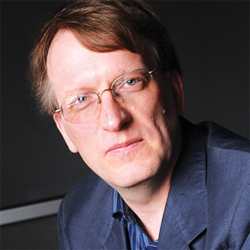Interview with Henning Schulzrinne on the coming COSMOS testbed
![]()

Last month, the National Science Foundation announced that it will fund COSMOS, a large-scale, outdoor testbed for a new generation of wireless technologies and applications that will eventually replace 4G. Covering one square mile in densely populated West Harlem just north of Columbia’s Morningside Heights campus, COSMOS is a high-bandwidth and low-latency network that, coupled with edge computing, gives researchers a platform to experiment with the data-intensive applications—in robotics, immersive virtual reality, and traffic safety—that future wireless networks will enable.
Columbia is one of three New York-area universities involved (with Rutgers and New York University being the other two). Columbia’s COSMOS proposal was overseen by principal investigator Gil Zussman (Electrical Engineering) who worked with a number of Columbia professors, including Henning Schulzrinne.
A researcher in applied networking who is also investigating an overall architecture for the Internet of Things (IoT), Schulzrinne has previous experience in setting up an experimental wireless network. In 2011, he oversaw the installation of WiMAX, an early 4G contender, on the roof of Mudd. WiMAX helped demonstrated the feasibility of doing wireless experiments on campus while also setting a precedent for the Computer Science Department to work with Columbia facilities, which ran the fiber, provided power, and installed the antennas.
In this interview, Schulzrinne discusses the benefits of COSMOS to researchers and students within and outside the department.
What is your role?
I have three separate roles. In the area of licensing and public policy, I did the spectrum license applications so the campus could use frequencies in the millimeter-wave radio band—not previously used for telecommunications—and I’ll work to ensure we don’t interfere with licensees who will someday be assigned those frequencies.
The way licensing is done will change under 5G. Instead of specifically requesting licenses for certain frequencies and then waiting for permission, or maybe an auction, as is done now, spectrum will be shared dynamically as needed, a more efficient way to use a limited resource. Part of COSMOS is to better understand how sharing of spectrum will work.
In the application area, I will be looking at both stationary and mobile IoT devices, putting mobile nodes on Columbia vehicles—buses and public safety and utility vehicles—to measure noise pollution, for example. I am also working with Dan Rubenstein on testing safety precautions with connected vehicles that use wireless connectivity and looking for ways to protect pedestrians and bicyclists.
And thirdly, for many years I have collaborated with researchers in Finland on a series of wireless spectrum projects, including mobile edge computing. These projects are funded by the NSF and the Academy of Finland through the WiFiUS program (Wireless Innovation between Finland and US). COSMOS gives us the chance to deploy and study mobile edge computing on a high-bandwidth, low-latency network.
Who will be able to access the test bed?
COSMOS is unique as an NSF project for building an infrastructure available to anyone, both on- and off-campus. In principle, anyone who has an email address at a US education institute can submit a proposal to use COSMOS for teaching and research.
While K-12 education plays an important role in this project—high school students, for example, might run experiments showing the propagation of radio waves—most educational interest and activity will likely be at the higher-education level, especially in networking and wireless classes, with both faculty and student researchers using the testbed to run experiments at a scale not possible in a lab.
What does COSMOS mean for Columbia researchers and students?
Columbia students, being physically close to the test bed, will have obvious advantages, like being able to easily enlist pedestrians or students for experiments on devices that are worn or carried.
I expect we’ll see many proposals coming out of the Computer Science Department in particular as we understand what becomes possible on these new networks where processing is done on edge servers rather than being sent up to cloud servers further away. Can we for instance control traffic lights to more efficiently move traffic along and increase safety of pedestrians and bicyclists? Can we use the network for augmented reality? Can public safety applications benefit from high-bandwidth video processing? Do the propagation characteristics force designers of network protocols to deal with short-lived connections with highly-variable transmission speed? The COSMOS testbed gives us a wireless infrastructure to find out.
Henning Schulzrinne is the Julian Clarence Levi Professor of Mathematical Methods and Computer Science at Columbia University. He is a researcher in applied networking and is particularly known for his contributions in developing the Session Initiation Protocol (SIP) and Real-Time Transport Protocol (RTP), the key protocols that enable Voice-over–IP (VoIP) and other multimedia applications. Active in public policy, he has twice served as Chief Technology Officer at the Federal Communications Committee (his most recent term ended October 2017). Currently he serves on the North American Numbering Council. Schulzrinne is a Fellow of the ACM and IEEE and a member of the Internet Hall of Fame. Among his awards, he has received the New York City Mayor’s Award for Excellence in Science and Technology, the VON Pioneer Award, TCCC service award, IEEE Internet Award, IEEE Region 1 William Terry Award for Lifetime Distinguished Service to IEEE, the UMass Computer Science Outstanding Alumni recognition.
Posted 05/14/2018

